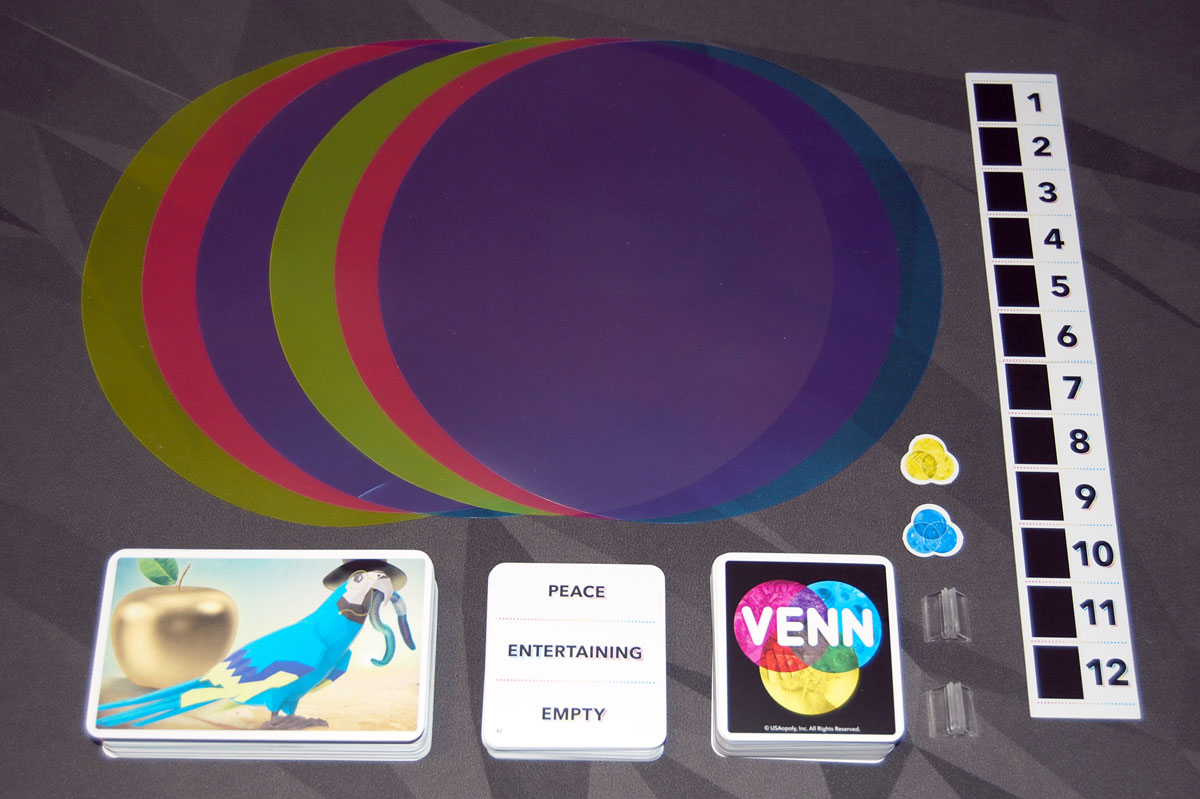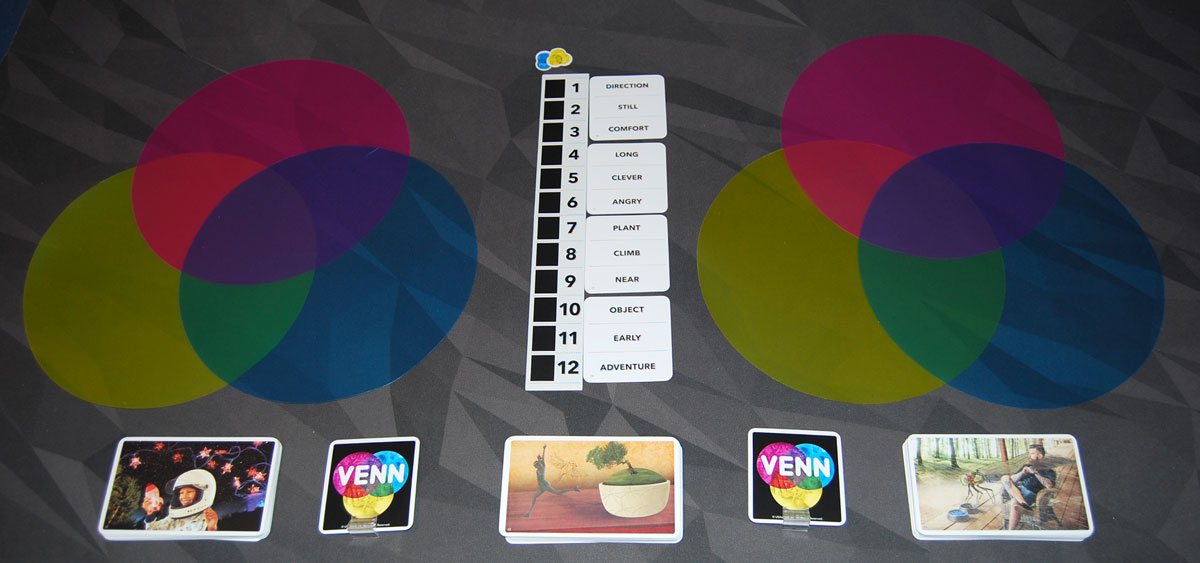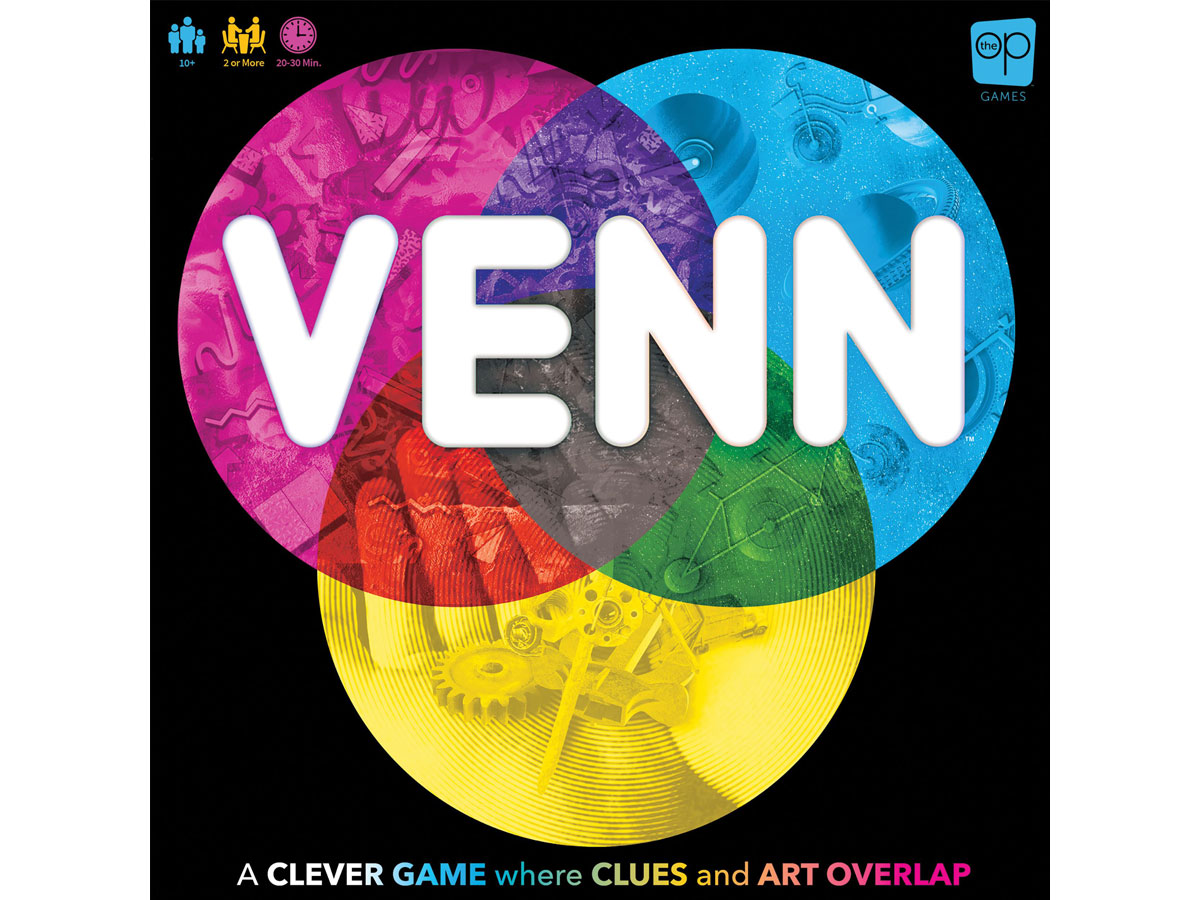What do the words “stretch,” “nature,” and “fancy” have in common? Time to use a Venn diagram!
What Is Venn?
Venn is a party game for 2 or more players, ages 10 and up, and takes about 20 to 30 minutes to play. It retails for $24.99 and is available in stores or directly from The Op. The main age requirement for Venn is simply having enough of a vocabulary to know what the clue words mean, but you can always swap out cards if a player isn’t sure of a definition.
Venn was published by The Op Games; no designer or artist credit is listed.

Venn Components
- 6 Venn circles
- 100 Art cards
- 50 Word cards
- 100 Number cards
- 2 Team Scoring markers
- 2 Number Card holders
- Score track
The Venn circles are large translucent plastic circles in pink, blue, and yellow. They’re floppy and flexible, and are used to form your Venn diagram for adding cards to.

The art cards are large and double-sided with different art on each side. Each one is a collage of photos and drawings, mostly somewhat surreal. There’s a wide variety of scenes, but the one thing they have in common is that there are at least a few disparate objects in each image, making it hard to say exactly which feature is most prominent in any given image.

One complaint I have, though, is that there’s very little ethnic diversity represented on the cards. I was curious, so I went through the whole deck and looked at the people in the images. The vast majority of the cards have at least one person or body part on at least one of the two images. Of those, I picked out any that could arguably considered people of color, and found only 11 cards (and in most of those, the image included white people in the same image). If I wanted to find a card with somebody who looked like me, I had two choices, and one I wasn’t entirely sure was Asian. That feels pretty disappointing.
Each of the number cards has 3 different numbers on it (from 1 to 12). I’m not sure that you actually need quite so many, but I guess you need enough that you won’t know which combinations aren’t represented (since there are 220 possibilities). The one thing I do wish is that the numbers were always listed in increasing order, because that would make finding the corresponding words easier. They’re also large square cards—presumably to match the word cards—but I’m not sure if they really need to be that big.

The word cards are double-sided, with three words on each side. They’re sized so that the cards can be lined up next to the scoreboard, and the words will line up with the numbers.
How to Play Venn
You can download a copy of the rulebook here.
The Goal
The game can be played competitively between two teams, or cooperatively. The goal of the competitive game is to be the first team to score 12 points. The goal of the cooperative game is to score 12 points using a limited set of number cards. I’ll explain the competitive game first, and then the differences for the cooperative game.

Setup
Give each team a set of the circles, which are placed in an overlapping fashion to form a Venn diagram. Shuffle the art cards, dividing it into three piles. Give one pile to each team, and set the third pile between the teams. Place the score track in the center, with the scoring tokens at the top. Shuffle the word cards and place four of them next to the score track.
Each team should have one player to be a clue giver, and the rest of the team will be guessers. Shuffle the number cards and give each clue giver a number card, which they place in the card stands.

Gameplay
Each clue giver looks at their number card and compares it to the corresponding words on the word cards. Those are the three words they want their team to guess. They secretly assign each word to one of the circles in their Venn diagram.
Teams play simultaneously, with no turns. At a signal, both teams begin playing.
Clue givers look through their stack of art cards and may play cards onto their Venn diagram. Each section of the diagram may only have one card; if you play to a section that already has a card, stack it on top to cover up the previous card. (Guessers are not allowed to look through covered cards.)
An art card that only matches one of your three words goes into the corresponding circle on the outside. If a card matches two of your words, you place it in the overlapping section between those two circles. And if the card relates to all three of your words, you place it in the center section.
The clue giver is not allowed to give any more signals or communications other than playing cards.

If there are at least 3 cards in the team’s diagram, the guessers may attempt to make a guess. They call out “Venn!” and both clue givers must stop placing cards. The guessers choose three words from the list as their guess. They do not have to identify which word goes with which circle; they just have to get the right words. For each word they get right, they get 1 point. Also, if they get all 3 words, they get a bonus point.
Then, the opposing team may make a guess; the second team does not score a bonus point for getting all 3 correct.
If nobody has reached 12 points, place a new set of word cards, change clue givers, and start a new round.
Game End
The game ends when a team reaches 12 points. They win! If there’s a tie, the team that scored the most points in the final round wins.
Cooperative Rules
The cooperative game is played in the same way, but instead of racing against another team you have a time limit. For each round, you set a 2-minute timer and the clue giver must stop playing cards when the timer rings and the guessers must guess. You do not score a bonus point for getting all 3 words.
The goal is to score 12 points, using only up to 5 number cards. If you have used 5 number cards and haven’t reached 12 points, you lose.

Why You Should Play Venn
Playing Venn reminds me a little bit of Codenames, because as a clue giver you’re trying to make certain connections and associations, while avoiding others. Ideally you want to find cards that can fill in every spot in your diagram: this card says “large” and this card says “sparkling” and this card says “large AND sparkling.” The more cards you can place, the more information your guessers have as they figure out what the overlaps are between images.
But, as with Codenames, it also helps to pay attention to the words on the list that aren’t yours. In one case I had placed a few cards that I thought were so obviously “horizontal” but my guesser noticed that all of them had water and guessed “waves” instead. It reminds me of the story about training AI on photos to recognize tanks, and instead it learned to recognize whether the sky was cloudy or clear. Because the cards have so many different features, there’s no guarantee that the feature you think is important is the one that your guessers will pay attention to.
Being able to place multiple cards in the same section can be helpful, even though you cover up the previous cards. As you replace cards, it can help to reinforce which features are shared across all of the cards you’ve played, though it does rely a bit on memory of what was on the covered cards.
Unlike Codenames, though, Venn is also about speed: the team that calls “Venn!” is eligible to score a bonus point if they get all three words, so there’s some time pressure involved. Plus, the other clue giver has to stop placing cards at that time, so if you can get cards on the board quickly and let your team guess, the other team may be stuck with fewer clues to reference.
Some words are decidedly harder to convey than others, and some combinations can be very tricky. For instance, in one game both “left” and “right” were on the word list, and the cards don’t necessarily have a lot of images that are clearly weighted in one direction or another. Another tough word is “real,” because on the one hand most of the things on the cards are made from photographs of real things … but the compositions are decidedly unreal. Your job may be much harder, just based on the number card you draw and the particular combination of word cards. I do like the way the word cards work, though—it gives a lot of variability in the words and word combinations that are possible, so you don’t get stuck on the same ideas.
The cooperative game is pretty good as well, but 2 minutes definitely feels short as a time limit, and keeps the pressure on. When I played with my 9-year-old, I gave her 5 minutes to place cards instead, just so she wasn’t frustrated with actually handling the large cards.
I think a lot of the fun of Venn, like many clue-guessing games, is discussing things after the answers are revealed. You can go back through cards that were covered up and see what they had in common, and see what your clue-giver was thinking when they placed that card in the center. And the clue-giver finally has a chance to talk as well, asking how you could possibly think this image meant “noisy” when it’s so clearly “blue.” Where Codenames relied a bit more on wordplay, Venn is a game about visual associations, so it may appeal more to those who think in pictures and like making those connections.
For more information about Venn, visit The Op Games website.
Click here to see all our tabletop game reviews.
![]() To subscribe to GeekDad’s tabletop gaming coverage, please copy this link and add it to your RSS reader.
To subscribe to GeekDad’s tabletop gaming coverage, please copy this link and add it to your RSS reader.
Disclosure: GeekDad received a copy of this game for review purposes.





